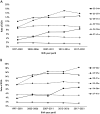Sustained decline in birth weight and increased rate of preterm infants born small for gestational age in Japan
- PMID: 39403350
- PMCID: PMC11472726
- DOI: 10.3389/fped.2024.1480527
Sustained decline in birth weight and increased rate of preterm infants born small for gestational age in Japan
Abstract
Background: Birth weights have continued to decline in Japan in recent years. However, secular trend changes such as the birth weight relative to the week of gestation remain to be explored. This study aimed to determine the trends over time in mean birth weight and small for gestational age (SGA) rate for each gestational week.
Methods: We used a large dataset of 27,015,792 births obtained from birth certificates between 1997 and 2021. Births from 22 to 41 weeks of gestation were evaluated in six groups (22-24, 25-27, 28-31, 32-33, 34-36, and 37-41 weeks of gestational age). For each group, secular trend changes in the z-scores calculated from standard birth weight values were assessed. Time trends in the proportion of SGA and mean birth weight z-scores were evaluated using the Cochran-Armitage trend test and linear regression analysis. Binomial logistic regression was performed to ascertain the effects of gestational age, sex, primiparity, number of births, and maternal age on the likelihood of SGA.
Results: The mean birth weight of preterm infants continued to decrease, and the z-score for mean birth weight decreased linearly, falling to -0.7 at 25-27 weeks of gestation from 1997-2001 (first period) to 2017-2021 (final period). Maternal age continued to increase from the first period to the last period for all weeks of gestation. There was a linear increase in the SGA rate in preterm infants born at <34 weeks. Odds ratios for the likelihood of SGA were 1.3 times higher for maternal age ≥40 years than that for 25-29 years (95% CI: 1.29-1.33, p < 0.001).
Conclusions: In Japan, there has been a continuous decline in birth weight and an increase in the rate of preterm SGA infants.
Keywords: advanced maternal age; low birth weight; nulliparous; parity; premature; preterm birth.
© 2024 Moriichi, Kuwahara and Kato.
Conflict of interest statement
The authors declare that the research was conducted in the absence of any commercial or financial relationships that could be construed as a potential conflict of interest.
Figures



Similar articles
-
Decreasing trend in preterm birth and perinatal mortality, do disparities also decline?BMC Public Health. 2020 May 26;20(1):783. doi: 10.1186/s12889-020-08925-w. BMC Public Health. 2020. PMID: 32456627 Free PMC article.
-
High birth weight and large-for-gestational-age in singletons born after frozen compared to fresh embryo transfer, by gestational week: a Nordic register study from the CoNARTaS group.Hum Reprod. 2021 Mar 18;36(4):1083-1092. doi: 10.1093/humrep/deaa304. Hum Reprod. 2021. PMID: 33416878
-
Growth and fatness at three to six years of age of children born small- or large-for-gestational age.Pediatrics. 1999 Sep;104(3):e33. doi: 10.1542/peds.104.3.e33. Pediatrics. 1999. PMID: 10469816
-
Risk of stillbirth, preterm delivery, and fetal growth restriction following exposure in a previous birth: systematic review and meta-analysis.BJOG. 2018 Jan;125(2):183-192. doi: 10.1111/1471-0528.14906. Epub 2017 Oct 3. BJOG. 2018. PMID: 28856792
-
New Option in the Lives Saved Tool (LiST) Allows for the Conversion of Prevalence of Small-for-Gestational-Age and Preterm Births to Prevalence of Low Birth Weight.J Nutr. 2017 Nov;147(11):2141S-2146S. doi: 10.3945/jn.117.247767. Epub 2017 Sep 13. J Nutr. 2017. PMID: 28904115 Review.
Cited by
-
Health-Related Quality of Life in Japanese Youth Born Extremely Low-Birthweight: Impact of Attention Deficit Hyperactivity Disorder.Acta Paediatr. 2025 Sep;114(9):2270-2278. doi: 10.1111/apa.70104. Epub 2025 Apr 22. Acta Paediatr. 2025. PMID: 40259864 Free PMC article.
References
-
- Castanys-Muñoz E, Kennedy K, Castañeda-Gutiérrez E, Forsyth S, Godfrey KM, Koletzko B, et al. Systematic review indicates postnatal growth in term infants born small-for-gestational-age being associated with later neurocognitive and metabolic outcomes. Acta Paediatr. (2017) 106:1230–8. 10.1111/apa.13868 - DOI - PMC - PubMed
-
- Diouf I, Charles MA, Blondel B, Heude B, Kaminski M. Discordant time trends in maternal body size and offspring birthweight of term deliveries in France between 1972 and 2003: data from the French national perinatal surveys. Paediatr Perinat Epidemiol. (2011) 25:210–7. 10.1111/j.1365-3016.2010.01188.x - DOI - PubMed
LinkOut - more resources
Full Text Sources

